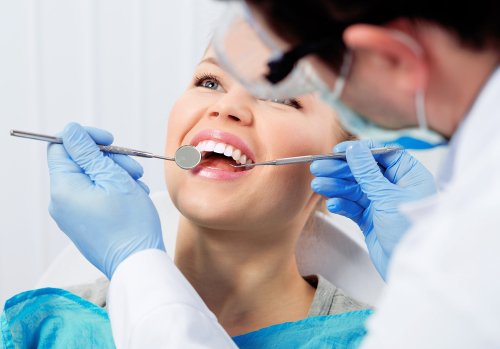Unknown Facts About Legacy Orthodontics
Unknown Facts About Legacy Orthodontics
Blog Article
The smart Trick of Legacy Orthodontics That Nobody is Talking About
Table of ContentsExamine This Report on Legacy OrthodonticsThe Best Strategy To Use For Legacy OrthodonticsGetting My Legacy Orthodontics To WorkSome Known Factual Statements About Legacy Orthodontics Top Guidelines Of Legacy Orthodontics
At Advanced Orthodontics, we supply clients with a alternative therapy experience. Furthermore, we offer adjustable treatment routines, flexible settlement alternatives and a fun, enjoyable experience. braces. Telephone call ( 480) 357-4900 today for additional information and timetable an appointment.An orthodontist is a dental practitioner educated to identify, stop, and treat teeth and jaw abnormalities. They fix existing problems and are trained to identify troubles that might create in the future. Orthodontists collaborate with individuals of any ages, from youngsters to grownups. Individuals often associate an excellent smile with health.
Malocclusion, or misaligned teeth, can result in dental problems, consisting of dental caries, gum illness, and challenging or agonizing chewing. However not every person is birthed with straight teeth. If you have a poor bite or large rooms between your teeth, you might wish to seek advice from a dental professional specializing in orthodontic treatment.
The Ultimate Guide To Legacy Orthodontics
( Photo Credit History: DigitalVision/Getty Images) Orthodontists make use of dealt with and detachable oral tools, like braces, retainers, and bands, to change the position of teeth in your mouth. Orthodontic treatment is for oral irregularities, including: Crooked teethBite troubles, like an overbite or an underbiteCrowded teeth or teeth that are too far apartJaw misalignmentThe goal of orthodontic treatment is to boost your bite.
A healthy bite ensures you can eat, eat, and talk effectively. While you could think about orthodontists as generally for youngsters or teenagers who need braces, they can fix dental issues at any type of age. Orthodontists participate in university, oral institution, and orthodontic school. After college graduation, they spend 2 or 3 years in an orthodontic residency program.
, however not all dental experts are orthodontists. They focus on 2 locations: Just how to appropriately and safely relocate teeth Just how to correctly assist development in the teeth, jaw, and faceOnce an orthodontist has completed training, they have the choice to end up being board licensed.
7 Simple Techniques For Legacy Orthodontics
Imbalance, or malocclusion, is the most usual reason people see an orthodontist. It is hereditary and is the result of dimension distinctions between the top and reduced jaw or between the jaw and teeth. Malocclusion leads to tooth overcrowding, an irregular jaw, or uneven bite patterns. Malocclusion is normally treated with: Your orthodontist connects steel, ceramic, or plastic square bonds to your teeth.
Some individuals require a headgear to help relocate teeth into line with stress from outside the mouth. A retainer is a personalized device that maintains your teeth in place.
They can develop extra area in the mouth without having to draw teeth. Orthodontists use cables, medical screws, or plates to sustain your jaw bone.
You might need to see an orthodontist if you have: Crowding or not adequate room for all of your teethOverbite, when your top teeth come by your bottom teethUnderbite, when your bottom teeth are as well much forwardSpacing or problems with gapsCrossbite, which is when your upper teeth fit behind your bottom teeth when your mouth is closedOpen bite or a vertical space between your front bottom and top teethMisplaced midline, when the facility of your base and upper teeth don't align Dealing with an oral malocclusion can: Make attacking, chewing, and speaking easierImprove the symmetry of our face and your general appearanceEase discomfort from temporomandibular joint problemsDifferent your teeth and make them much easier to clean, aiding protect against dental caries or cavities It's typically a dental professional who first notices misaligned teeth during a regular exam.
Our Legacy Orthodontics PDFs

Throughout your initial orthodontic assessment, you'll likely have: A dental examPhotos taken of your face and Full Report smileDental X-raysPanoramic (360 degree) X-rays of your face and headImpressions to develop mold and mildews of your teethThese tests will help your orthodontist know exactly how to wage your treatment. invisalign. An orthodontist is a dental professional who's had training to treat your teeth and jaw
An orthodontist is concentrated on your bite, so something like a broken tooth would certainly be handled by a dental professional. Orthodontists are focused on your bite, or the means your teeth fit with each other, and the straightness of your teeth.
Ever asked yourself just how celebrities always seem to have completely aligned teeth? Orthodontists are dental professionals who focus on fixing irregularities in the teeth and jaws.
The Single Strategy To Use For Legacy Orthodontics

While dental braces are one of the most frequently acknowledged orthodontic therapy, orthodontists have a diverse toolkit at their disposal. The details method picked depends upon the intensity of the instance, the individual's age, and specific choices. These reliable dental braces use a system of braces bonded to the teeth and attached by cables.
Clear aligners, like Invisalign, are a popular option for patients looking for a much more very discreet therapy option. These removable trays are tailor-made to gradually shift the teeth's position. Headwear may be utilized in conjunction with braces or aligners to apply additional targeted pressures, particularly for fixing jaw discrepancies. In cases of narrow jaws, palatal expanders can be made use of to develop room for correct tooth positioning.
Report this page